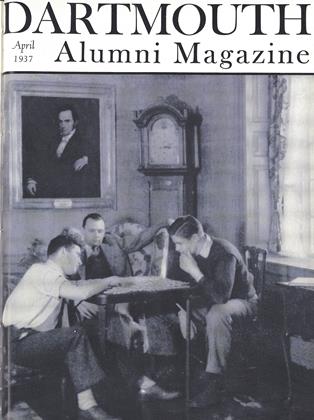A DEPARTMENT OF THE D. O. C. AND ACTIVITIES OF INTERESTEDSTUDENT NIMRODS ARE DEVOTED TO CONSERVATION
SEVERAL STUDENTS working in a new division of the Dartmouth Outing Club, the Department of Fish and Game, have initiated and carried on game conservation work here at Dartmouth. An area of ground has been chosen quite near Hanover which has been mapped and photographed to show the types of food and cover present. As part of our program shrubs have been transplanted on this area to provide food for the ruffed grouse, the native game bird in this vicinity, during the months when natural food is scanty. We were also prepared to feed these birds with cracked corn and grit, but, in view of the fact that the grouse is a difficult bird to entice by artificial feeding, and considering the mild winter that we have experienced, it is not likely that the birds have been benefited by our efforts. The experience which we have obtained in the technique of building feeding stations and providing food, however, has been of value to us. In cooperation with the State Department of Fish and Game we were able to assist in the stocking of our area with over a hundred rabbits. Plans for this work were discussed at weekly meetings of our Department, and also at this time each member in his turn delivered a short talk on some subject relative to hunting and fishing. At the present time one of the group is giving lessons on tying trout flies in anticipation of the approaching trout season.
In addition to this work a study of the incidence of internal parasites of the grouse was made by the undergraduates during the hunting seasons of 1935 and 1936. Since this bird is subject to severe fluctuations in numbers every eight to ten years it was felt that perhaps the importance of parasites in these fluctuations could be determined in this vicinity. Food, vermin, weather and hunting also affect the status of the grouse, but facilities were such that the problem of parasitism was deemed the most advisable one to study.
In the mid-west during the fall of 1935 rapid diminuation in the numbers of grouse was reported and it was anticipated by many workers that this drop would reach the east shortly. It is probable that this decrease occurred here this past fall because grouse were reported scarce in this region as was reported elsewhere throughout the east.
STUDY OF BIRDS SHOT
Thus, living as we do in a region where enthusiasm for grouse shooting runs high, particularly among some of the undergraduates in the D. O. C., it seemed that an investigation of this bird might be heartily supported. Several of the faculty and townspeople, upon being questioned as to their interest in such a project, promised support. Our study was made in the Zoology ogy laboratories of the college in cooperation with Prof. F. H. Connell '28.
While over thirty parasites and diseases have been reported from the grouse, only two species of parasites were found among the seventy birds examined from the vicinity of Hanover during the hunting seasons of 1935 and 1936. One of the species is not disease producing and the other is relatively harmless in such numbers as it occurred in the birds examind by us.
Our investigation shows that there was no greater incidence of parasitism in birds examined in 1936 than in 1935. Thus no parasites found by us could be held responsible for such fluctuations as have been observed during the past year in the grouse. However, there has been reported by C. H. D. Clarke, working in Ontario, a malaria-like organism in the ruffed grouse which is capable of bringing about a rapid decrease in the young birds. Since our examinations were conducted in the fall of the year we would not have been likely to find this parasite because it attacks young birds which, by the time our examinations were made, would have either perished or become carriers, in which state detection is impossible by any means available to us.
LEARNING ABOUT CONSERVATION
While it is unlikely that any immediate benefit to the grouse has accrued from our efforts, a start has been made, which if continued in the years to come should prove helpful to the birds. In the meantime, many of us, who would have been interested only in hunting, have learned to feel greater appreciation for the difficulties in the conservation of one of our favorite game birds.
RUFFED GROUSE A FAVORITE GAME BIRD
HENRY DOREMUS '37 Head of the Outing Club's departmentof fish and game and a zoology majorwhose interests in conservation work innorthern New Hampshire are describedin this undergraduate number of the ALUMNI MAGAZINE.
RAINBOWS THRIVE IN FAST WATER
 View Full Issue
View Full Issue
More From This Issue
-
 Sports
SportsDeaths
April 1937 -
 Article
ArticleFootball From the Inside Out
April 1937 By DAVID M. CAMERER '37 -
 Sports
SportsFollowing the Big Green Teams
April 1937 By ROBERT P. FULLER '37 -
 Class Notes
Class NotesClass of 1902
April 1937 By Hermon W. Farwell -
 Class Notes
Class NotesClass of 1927
April 1937 By Doane Arnold -
 Article
ArticleGradus Ad Parnassum
April 1937
Article
-
 Article
ArticleRECIPIENTS OF THE DEGREE OF BACHELOR OF SCIENCE
AUGUST, 1907 -
 Article
ArticleSecretaries Meet
JUNE 1932 -
 Article
ArticleD. C. A. C. Finances
October 1947 -
 Article
ArticlePHOENIX FROM THE ASHES
November 1932 By J. S. M -
 Article
ArticleProf's Choice
October 1993 By Professor Susan Ackerman -
 Article
ArticleJUNTO ORGANIZES
March 1934 By S.H. Silverman '34

